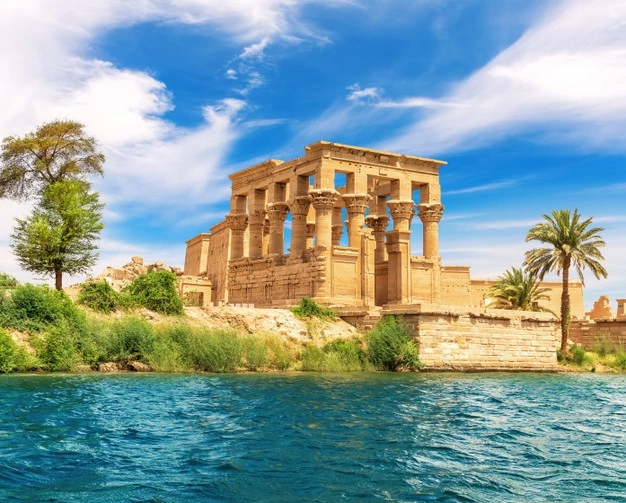The Temple of Isis at Philae

Overview:
The Temple of Isis originally sat on the island of Philae in the middle of the Nile River in the southern part of the ancient Egyptian empire. The temple was built by followers of the cult of Isis, a goddess often referred to as the mother of the gods. The walls portray scenes of the resurrection of her husband Osiris, his later mummification, and the birthing of their son Horus, one of the most prominent gods in the ancient Egyptian pantheon.
Philae is a rocky island in the middle of the Nile

- . The original island of Philae was considered sacred due it being one of the many legendary burial places of Osiris, a god of fertility, death, and rebirth. Since only the religiously devout were allowed to live there, it was referred to as “the Unapproachable” by ancient Romans who later conquered and occupied Egypt. It was said that fish never swam close and fowl refused to fly above the sacred land. While remaining a holy site, the island itself also functioned as part a major trade route and was often visited by merchants and those vacationing on pilgrimage.
- • Although shrines dedicated to the worship of Isis were built earlier on the island, major construction of the temple was carried out by Ptolemy II and later his successor Ptolemy III, whose reigns lasted from 285-221 BC. Later Roman leaders Augustus and Tiberius continued to decorate the site from 27-37 BC, but their works were never completed. A western gate was added to the complex by the Romans between 117 AD and 138 AD. Following the rise of Christianity, the temple was officially closed in 537 AD and rededicated to the worship of Saint Stephen.
- • At the very beginning of the 1900s, the temple complex was flooded due to the construction of the Aswan Low Dam. By the 1960s, a third of Philae’s ancient structures were permanently submerged, and underwater damage stripped the site of its vegetation and colorful reliefs. In 1960, UNESCO began a 20-year rescue project that lowered the inundation and saw around 50,000 stones moved to its current site on nearby Agilkia Island where you can still visit and explore the temple to this day.